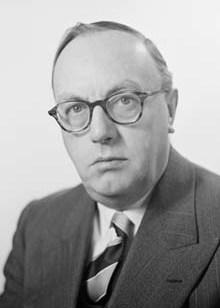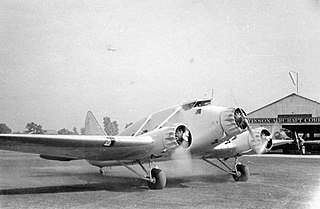
Trans Australia Airlines (TAA), renamed Australian Airlines in 1986, was one of the two major Australian domestic airlines between its inception in 1946 and its merger with Qantas in September 1992. As a result of the "COBRA" project, the entire airline was rebranded Qantas about a year later with tickets stating in small print "Australian Airlines Limited trading as Qantas Airways Limited" until the adoption of a single Air Operator Certificate a few years later. At that point, the entire airline was officially renamed "Qantas Airways Limited" continuing the name and livery of the parent company with the only change being the change of by-line from "The Spirit of Australia" to "The Australian Airline" under the window line with the existing "Qantas" title appearing above.

Sydney Kingsford Smith Airport is an international airport in Sydney, Australia, located 8 km (5 mi) south of the Sydney central business district, in the suburb of Mascot. The airport is owned by Sydney Airport Holdings. It is the primary airport serving Sydney and is a primary hub for Qantas, as well as a secondary hub for Virgin Australia and Jetstar, and a focus city for Air New Zealand. Situated next to Botany Bay, the airport has three runways. Sydney Kingsford Int'l Airport covers 907 hectares of land.

Ansett Australia was a major Australian airline group, based in Melbourne, Victoria. The airline flew domestically within Australia and from the 1990s to destinations in Asia. After operating for 65 years, the airline was placed into administration in 2001 following a financial collapse and subsequent organised liquidation in 2002, subject to deed of company arrangement. The last flight touched down on 5 March 2002.
Kendell Airlines was a regional airline of Australia, in the 1990s the largest in the country. It served major regional centres in New South Wales, Victoria, South Australia and Tasmania from Melbourne, Adelaide, and Sydney. Many of its services were in co-operation with its parent company Ansett Australia from the 1990s.

The de Havilland Express, also known as the de Havilland D.H.86, was a four-engined passenger aircraft manufactured by the de Havilland Aircraft Company between 1934 and 1937.

MacRobertson Miller Airlines (MMA) was a Western Australian airline that operated between 1927 and 1993. After being purchased by Ansett Transport Industries in 1968, it was eventually rebranded Ansett WA.

On 10 June 1960, a Fokker Friendship passenger aircraft operated by Trans Australia Airlines (TAA) was on approach at night to land at Mackay, Queensland, Australia when it crashed into the sea. All 29 people on board Trans Australia Airlines Flight 538 were killed.

On 26 June 1950, a Douglas DC-4 Skymaster aircraft departed from Perth, Western Australia, for an eight-hour flight to Adelaide, South Australia. It crashed 22 minutes after take-off, 35 miles (56 km) east of Perth Airport. All 29 occupants were killed in the accident; one initially survived, but died six days later. It was the worst civil aviation accident in Australia.

Australian National Airways (ANA) was Australia's predominant aerial carrier from the mid-1930s to the early 1950s.

United Air Lines Flight 297 was a scheduled flight from Newark International Airport to Atlanta that crashed 10 miles (16 km) southwest of Baltimore on November 23, 1962, killing all 17 people on board. An investigation concluded that the aircraft, a Vickers Viscount 745D turboprop airliner, had struck at least two whistling swans, which caused severe damage to the plane, resulting in a loss of control.

BCPA Flight 304/44 was a scheduled flight operated by British Commonwealth Pacific Airlines from Sydney, Australia, to Vancouver, Canada, with scheduled stops at Fiji, Canton Island, Honolulu and San Francisco. On 29 October 1953, the flight was conducted by a Douglas DC-6 named Resolution and registered in Australia as VH-BPE. The propliner crashed during its initial approach towards San Francisco International Airport, killing all 19 people on board, including the American pianist William Kapell.

Capital Airlines Flight 75 was a domestic scheduled Capital Airlines passenger flight between LaGuardia Airport and Hartsfield–Jackson Atlanta International Airport in Atlanta, Georgia. A Vickers Viscount flying the route crashed near Chase, Maryland, on May 12, 1959, with the loss of all on board. The crash was the third of four involving a Capital Airlines Vickers Viscount in less than two years; the other three were Capital Airlines Flight 67, Capital Airlines Flight 300, and Capital Airlines Flight 20.

Advance Airlines Flight 4210 was a scheduled passenger flight which crashed at Sydney Airport on 21 February 1980, killing all 13 people on board the Advance Airlines Beech Beechcraft King Air 200. After taking off on runway 25 for a scheduled flight the aircraft's left (port) engine failed and the pilot requested an emergency landing on runway 34. The plane crashed into the sea wall while attempting the emergency landing. The accident caused the greatest number of fatalities in a civil aircraft crash in Australia since MacRobertson Miller Airlines Flight 1750, a Vickers Viscount that crashed near Port Hedland in Western Australia on 31 December 1968 killing all 26 on board.

Sir John Armstrong Spicer was an Australian lawyer, politician, and judge. He served two terms as a Senator for Victoria, representing the United Australia Party (UAP) from 1940 to 1944 and the Liberal Party from 1950 to 1956. Spicer was Attorney-General in the Menzies Government from 1949 to 1956. He left politics to become chief judge of the newly created Commonwealth Industrial Court, a position which he held until 1976.
On July 28, 1943 American Airlines Flight 63 was flown by a Douglas DC-3, named Flagship Ohio, routing Cleveland-Columbus-Dayton-Cincinnati-Louisville-Nashville-Memphis, that crashed on the Louisville-Nashville sector about 1.6 miles (2.6 km) west of Trammel, Kentucky. The aircraft descended from 200 feet (61 m) until it struck trees, then slid across an open field and stopped in an upright position. Of the 22 people on board, 20 died. The cause of the crash was loss of control due to severe turbulence and violent downdrafts.

Northwest Airlines Flight 421 was a domestic scheduled passenger flight from Chicago, Illinois to Minneapolis, Minnesota that crashed on 29 August 1948. The Martin 2-0-2 aircraft, operated by Northwest Airlines, suffered structural failure in its left wing and crashed approximately 4.1 miles (6.6 km) northwest of Winona, Minnesota, about 95 miles (153 km) southeast of Minneapolis. A Civil Aeronautics Board investigation determined that the crash was caused by fatigue cracks in the wings of the aircraft, and recommended lower speeds and frequent inspections of all Martin 2-0-2 aircraft. All 33 passengers and four crewmembers on board were killed. The crash was the first loss of a Martin 2-0-2, and remains the worst accident involving a Martin 2-0-2.

On 31 December 1968 a Vickers Viscount aircraft departed from Perth, Western Australia for a flight of 724 nautical miles (1 341 km) to Port Hedland. The aircraft crashed 28 nautical miles (52 km) short of its destination with the loss of all twenty-six people on board. More than half of the right wing, from outboard of the inner engine to the wingtip, including the outer engine and its propeller, broke away from the rest of the aircraft in flight and struck the ground a significant distance from the main wreckage. Investigation by the Australian Department of Civil Aviation and British Aircraft Corporation concluded that a mysterious action during maintenance led to extensive fatigue cracking in the right wing spar. This accident remains the third worst in Australia's civil aviation history.

Ansett-ANA Flight 149 crashed near Winton in Queensland, Australia on 22 September 1966, killing all on board. The Vickers Viscount aircraft departed from Mount Isa, Queensland, Australia for a 73-minute flight to Longreach. Forty-four minutes after takeoff a fire started in one of the engines. The crew were unable to extinguish the fire or feather the propeller so made an emergency descent with the intention of landing at Winton, a small town along the route. The fire spread to the fuel tank and weakened the wing structure so that a large part of the left wing broke away and the aircraft crashed. All twenty-four occupants were killed. The accident remains the fifth-worst in Australia's civil aviation history.

On 10 March 1949 a Lockheed Lodestar aircraft became airborne at Coolangatta, Queensland, Australia for a flight to Brisbane. Before reaching a height of 300 feet (90 m) it suddenly pitched nose-up, stalled and crashed onto its belly beyond the end of the airstrip.

On 31 January 1945 a Stinson Model A aircraft departed from Melbourne for a flight of 127 nautical miles (235 km) to Kerang, Victoria—the first leg of an Australian National Airways regular scheduled service to Broken Hill, New South Wales. It crashed 50 nmi (93 km) from Melbourne. All ten occupants were killed in the accident. The aircraft was one of four Stinsons imported in 1936 by Airlines of Australia (AoA). Three had now crashed with the loss of 17 lives, and the fourth would not be permitted to fly again.



















